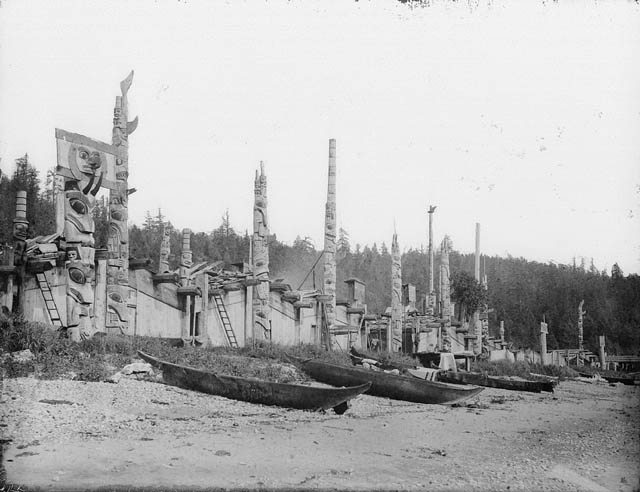Skidegate, 26 July 1878 (George Mercer Dawson, Geological Survey of Canada, NAC-PA-37756). Repeat photograph required.
1774: Spanish Reach Haida Gwaii
Why isn’t the current population of the Pacific Northwest largely Hispanic like much of the rest the Americas? What would have happened to northwest ecosystems and cultures if the great gold rushes to the California, Cariboo, and Yukon gold fields had happened two hundred years earlier and had been led by Spanish conquistadors? The Spanish began to sail the Pacific Ocean in the 1500’s, yet for nearly 2 centuries they rarely ventured further north up the coast than Baja California. Despite hundreds of trans-Pacific passages by galleons to Manila trading silver for silk, the Spanish never reached north to be the first Europeans to visit the Hawaiian people 1.
But in the mid-1700s the Spanish government learned of the Russian fur traders advancing southwards from the Aleutian Islands. To meet this threat to their western possessions, in 1868 they built a fortified harbour at San Blas in the Gulf of California, and within a decade established more northern outposts at San Diego, Monterey, and Los Angeles 2 In January, 1774 Juan Pérez, a pilot from the Spanish navy was dispatched from San Blas, Mexico in the ship Santiago to establish Spain’s imperial claim to the northwestern coast. On July 18 Pérez reached the Haida Gwaii (formerly called Queen Charlotte Islands) and met Haida peoples on the waters likely off of Dadens village on North Island. 3
In the 1700s, the Haida nation numbered 6-8 thousand, and occupied numerous communities throughout the archipelago. However a series of epidemics, especially an outbreak of smallpox in 1863, sharply reduced Haida numbers. By the time the first photographers reached the islands, the Haida had consolidated into fewer communities such as Skidegate, Massett, and Nin-stints Here, the early photographs show the exceptional wood-working capability of the Haida in construction of boats, houses and totems. These features are just the most visible evidence of the complex, long-evolved Haida culture that influenced their island ecosystem. These people were sustained mainly by salmon and halibut, and travelled widely from their isolated archipelago to trade with other peoples. 4
< Previous page Fur Trade Chapter Overview Next page>
Map and Footnotes
- Mann, C. C. 1493: Uncovering the New World Columbus Created. New York: Knopf, 2011. ISBN 978-0-307-26572-2 provides a recent description of Spanish cultural and economic priorities on the west coast of the Americas ↩
- Cook, W. L., Flood Tide of Empire: Spain and the Northwest, 1543-1819. New Haven: Yale University Press, 1973; Weber, D. J. “The Spanish Moment in the Pacific Northwest.” In Terra Northwest: Interpreting People and Place, edited by D. H. Stratton, 3-23. Pullman, WA: WSU Press, 2007 ↩
- Gough, B. M. Fortune’s a River: The Collision of Empires in Northwest America. Madeira Park: Harbour Publishing, 2007 ↩
- Cole, D. and B. J. Lockner, eds. To the Charlottes: George Dawson’s 1878 Survey of the Queen Charlotte Islands. Vancouver: UBC Press, 1993. ISBN 0-7748-0415-7; Fedge, D.W., and R.W. Mathewes, eds. Haida Gwaii: Human History and Environment from the Time of Loon to the Time of the Iron People. Vancouver: UBC Press, 2005. ↩
